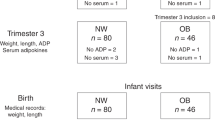Abstract
OBJECTIVE: To determine whether low birthweight is associated with higher plasma leptin concentrations in adult life and whether leptin contributes to the metabolic alterations in adults that are associated with reduced foetal growth.
DESIGN: Measurement of plasma leptin concentrations in a group of 502 men and women, aged 61–73, who were born in Hertfordshire and for whom records of birth and infant weight are available. Glucose tolerance was measured with a standard 75 g oral glucose tolerance test.
MEASUREMENTS: Leptin concentrations were assayed in fasting plasma samples using a radioimmunoassay.
RESULTS: Leptin concentrations ranged from 1.4 to 128.9 (mean 13.4) ng/ml and were higher in the 193 women than the 309 men (23.4 vs. 7.1 ng/ml). In both sexes leptin concentrations correlated positively with body mass index (r=0.65 in both men and women). Leptin concentration also correlated with fasting insulin (r=0.41) and with glucose and insulin concentrations 2 h after a glucose load (r=0.19 and 0.49). Adults with lower birth or infant weight had higher leptin concentrations than those of higher birthweight with similar degrees of obesity (P=0.02 and 0.06, respectively). Although both 2 h glucose and insulin concentrations negatively correlated with birthweight (r=−0.17, P<0.001 and r=−0.18, P<0.001, respectively), regression analysis suggested that the higher levels of leptin in adults who had low birthweight did not explain the association between low birthweight and glucose or insulin concentrations.
CONCLUSION: These results suggest that adults who had had low birthweight had higher plasma concentrations of leptin than would be expected from their degree of obesity. The higher leptin concentrations, however, do not account for the association between birthsize and glucose tolerance. They may be a consequence of the altered body composition, hyperinsulinaemia, and other long-term endocrine changes associated with reduced foetal growth.
This is a preview of subscription content, access via your institution
Access options
Subscribe to this journal
Receive 12 print issues and online access
$259.00 per year
only $21.58 per issue
Buy this article
- Purchase on Springer Link
- Instant access to full article PDF
Prices may be subject to local taxes which are calculated during checkout
Similar content being viewed by others
Author information
Authors and Affiliations
Corresponding author
Rights and permissions
About this article
Cite this article
Phillips, D., Fall, C., Cooper, C. et al. Size at birth and plasma leptin concentrations in adult life. Int J Obes 23, 1025–1029 (1999). https://doi.org/10.1038/sj.ijo.0801050
Received:
Revised:
Accepted:
Published:
Issue Date:
DOI: https://doi.org/10.1038/sj.ijo.0801050
Keywords
This article is cited by
-
Immune dysfunction in developmental programming of type 2 diabetes mellitus
Nature Reviews Endocrinology (2021)
-
Low birth weight leads to obesity, diabetes and increased leptin levels in adults: the CoLaus study
Cardiovascular Diabetology (2016)
-
Is a child’s growth pattern early in life related to serum adipokines at the age of 10 years?
European Journal of Clinical Nutrition (2014)
-
Association of nutrition in early life with body fat and serum leptin at adult age
International Journal of Obesity (2013)



